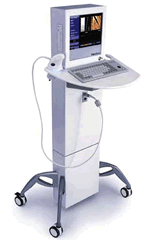Hepatitis
C Treatment and Normal Glucose Metabolism Promote Improved Fibrosis in HIV Positive
People
 | HIV
positive individuals who received treatment for hepatitis C virus (HCV) infection
and maintain good control of their blood sugar level have a better chance of experiencing
regression of liver fibrosis, according to a poster presentation at the Fifth
International AIDS Society Conference on HIV Pathogenesis, Treatment, and Prevention
last week in Cape Town, South Africa. |
By
Liz Highleyman  Researchers
from Hospital Carlos III in Madrid, Spain, used the non-invasive transient elastometry,
or FibroScan, method to estimate changes in liver
fibrosis in a prospective cohort of HIV positive
individuals established in 2004. Researchers
from Hospital Carlos III in Madrid, Spain, used the non-invasive transient elastometry,
or FibroScan, method to estimate changes in liver
fibrosis in a prospective cohort of HIV positive
individuals established in 2004.
In
2008, the investigators analyzed factors related to fibrosis regression among
632 participants who received 2 FibroScan examinations at least 18 months apart
(median separation 27 months). Most (78%) were men, the median age was 45 years,
the median body mass index (BMI) was 23, 9% were heavy alcohol users, 72% were
coinfected with HCV, 10% were coinfected with hepatitis B virus (HBV), and the
median CD4 count was 494 cells/mm3. Fibrosis
regression was defined as a decrease of at least 30% in "liver stiffness"
in patients with a stiffness measurement of 9.2 kiloPasals (KPa) at the time of
the first FibroScan, representing advanced fibrosis
or cirrhosis (Metavir stage
F3-F4). The
researchers prospectively recorded metabolic and HIV-related parameters at the
time of the first FibroScan and then every 3 months until the second liver scan.
They also looked at the presence and treatment of hepatitis
B and C, alcohol use, and antiretroviral
therapy characteristics. Results  | On
the first FibroScan reading, 193 participants (30%) had stage F3-F4 liver fibrosis. |  | At
the time of the second FibroScan, 65 patients (10%) met the criteria for fibrosis
regression. |  | Compared
to patients without fibrosis regression, patients who experienced improvement
were less likely to be male (67.7% vs 83.6%; P=0.01) and were more likely to have
been treated for hepatitis C (81.3% vs 44.2%; P < 0.001). |  | Patients
with fibrosis regression had a greater decrease in glycemia between the two FibroScan
measurements (-3.2 vs 1.9 mg/dL; P=0.04) and had lower HIV RNA levels at the time
of the second scan (1.8 vs 2.1 log copies/mL; P=0.001). |  | In
a multivariate analysis, the factors independently related to fibrosis regression
were treatment for hepatitis C (odds ratio 3.8; P=0.02) and, to a lesser but still
significant extent, glycemic improvement (odds ratio 1.05; P=0.03). |
"Treatment
of hepatitis C and better control glycemic control are associated with an improvement
in liver fibrosis in HIV-infected patients," the researchers concluded. "No
differences were found in terms of exposure to antiretroviral agents." Hospital
Carlos III, Infectious Diseases, Madrid, Spain 7/31/09 Reference
JV
Fernández Montero, P Labarga, P Barreiro, and others. Factors
associated with improvement of liver fibrosis in a large cohort of HIV-infected
patients followed for 5 years. 5th International AIDS Society Conference on
HIV Pathogenesis, Treatment, and Prevention (IAS 2009). July 19-22, 2009. Cape
Town, South Africa. Abstract
WePeB218.
| |